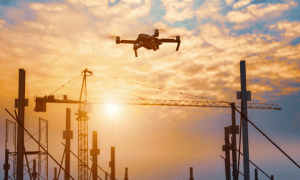🕑 Reading time: 1 minute
In this era of technology, the use of lasers has a very vast application in highway engineering. It is used for various purposes like road profiling, pavement surface deflection, bridge deflection, speed checkers, etc.
These techniques have eased human efforts by making it simple and easy to use. If compared to older methods that were cumbersome, these have higher accuracy as it is automated and quicker in obtaining results, which is computed by a computer and needs very less human power.
The major four application of laser in the highway engineering are discussed below:
1. Road Profiling
The profile of a road is measured along any constant non-existent line or object. The profile of a road taken along a lateral line demonstrates the superelevation and crown of the road outline, in addition to rutting and different problems. The longitudinal profile demonstrates the roughness, texture, design grade.
A laser profiler is used to find the following ingredients of a road profile:
- A reference elevation
- A height relative to the reference, and
- Longitudinal distance.

The applications of laser profiler in the highway engineering are:
- To screen the state of a road system for pavement management systems (PMS),
- To assess the nature of recently developed or repaired areas,
- To analyze the state of a particular place and decide fitting cures, and,
- To examine the state of a particular site for research. At the other end, an examination system may include incessant estimations of destinations that are only a few hundred feet long, to recognize unobtrusive types of decay at their onset.
2. Pavement Surface Deflections
The pavement surface deflection is measured using :
Rolling Wheel Deflectometer
The rolling wheel deflectometer was developed by Applied Research Associates (ARA), Inc. to quantify pavement surface diversions at traffic speeds and to portray the heap conveying limit of in-administration pavements.
This instrument comprises of a 53 ft long semitrailer applying a standard 18,000-lb load on the pavement structure by the means of standard double tire get together over the single back pivot.

Working Spatially-Coincident Method
The RWD measures wheel diversions at the pavement surface by method for a spatially incidental technique, which looks at the profiles of the surface in both undeflected and avoided states. As the RWD goes on top of the pavement, triangulation lasers mounted on a 25.5-ft aluminum shaft and put at 8-ft interims are utilized to gauge surface avoidances.
Three spot lasers are put before the stacked wheel to characterize the emptied surface, and one spot laser is explicitly set on top of the double-stacked tire to get together to gauge the diverting surface. The laser sensors are placed to gather a reading at a settled interim of 0.6 in at all truck speeds.
3. Bridge Deflection
The deformation in the bridge is caused by changes in natural conditions and long-term load and overload. The measurement of the deformation is important to know the health of the bridge in order to ensure the safe use of it.
To measure the deformation, new methods of deformation monitoring with the development of computer technology, sensor technology, and network technology, such as Stretched wire,tilt-meter, GPS, optical fiber, laser image. These methods can realize real-time on-line and automatic measurement of bridge deflection, which is low on maintenance cost and high precision.

The deflection measurement system is composed of laser emitter, laser receiver, and upper computer, as shown in the figure below. The laser beam should have long-term stability, anti-interference, and high positioning accuracy to ensure the accurate positioning of the spot center.
4. Speed Checkers
The vehicle speed detection is crucial for observing speed limitation law, and it also demonstrates traffic condition. The speed of the vehicle more than the defined limit is dangerous, which creates the chances of accidents.

The intelligent transportations system (ITS) is a new approach to manage traffic vehicles. These systems are becoming more critical due to their advantages like saving lives, money, and time.
Lasers have been used in the detection of the speed of the vehicle to mitigate the hazardous events on the road. The highway speed checker comes handy for the traffic police, especially against the speed limit violators because it provides the digital display as well as buzzing sound or alarm to detect any vehicle speed if the vehicle exceeds the permitted speed limit.
Application of Lasers in Highway Engineering
- The laser-based system can measure the road profile and deflection accurately while traveling at an average speed.
- It results in rapid measurement and quick data collection.
- Multiple locations can be measured from a single instrument position.
- It doesn’t require any setup or break down.
- It can be installed on any vehicle required by the user.
- It can operate at a speed of 105 km/h.
- It collects data in real-time as it traverses the pavement’s surface.
- It eliminates the need for lane closures or traffic control while testing.
The uses of lasers in highway engineering are road profiling, pavement surface deflection, bridge deflection, speed checkers, etc.
The highway speed checker comes handy for the traffic police, especially against the speed limit violators because it provides the digital display as well as buzzing sound or alarm to detect any vehicle speed if the vehicle exceeds the permitted speed limit.
Read More:
1. Laser Crack Measurement System for Pavements – Application and Advantages
2. 5 Ways Drones are Revolutionizing the Construction Sector


